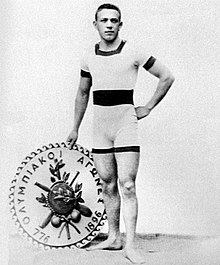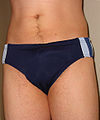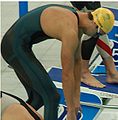Swimwear
As Swimwear clothes on is called, swimming is worn or bathing. It covers the body to a different extent. Women usually wear a bathing suit (Swiss bath dress , bathing dress ) for swimming . A two-piece suit is called a bikini . Men usually wear swimming trunks or one-piece swimsuits .
Swimwear for both sexes
Community pools, bathing facilities or beaches as we know them today only became popular towards the end of the 19th century. Before that, people only bathed - if at all - in the bathing or health resorts that have been known since the Middle Ages, mostly in bathtubs. Swimwear was of no great importance in these, privacy allowed naked bathing and the lack of swimming facilities meant that heavy cotton clothing was no problem either. The first real (beach) bathing establishments appeared in Europe at the end of the 19th century. These were first visited - strictly separated by gender - in the most opaque and woolen clothing possible, everything else was considered immoral, especially with women. Woven cotton is not very elastic, becomes very heavy when wet and only dries very slowly. While around 1900 more comfortable and elastic knitwear for men became socially acceptable for gymnastics and swimming , women who dressed in the same way were fined or even arrested, such as Annette Kellerman in 1907. Real sports and swimwear only began with to develop the hygiene and health discourse, the reform dress discourse of the physical culture movements and the associated health and life advice. These movements enabled the general acceptance of more comfortable clothing and the liberation of the female body, especially from the corset . Swimwear in today's sense has been popular since the interwar period. The first Swiss bathing fashion show took place in 1930 in the Lido (Seebad) in Lucerne .
In the early 20th century, swimwear was increasingly required on beaches, where nude bathing had previously been tolerated. In addition to the shame (of others), nude bathing has another disadvantage: swimwear, which an entire branch of industry earns well from and with which people also like to present themselves, becomes meaningless. In any case, swimwear, which is becoming increasingly scarce at times, does not protect against cold and wet.
Although they are more common in women, bathing caps are worn by both men and women. This is due, on the one hand, to the hairstyle protection of a bathing cap and, on the other hand, to the obligation to wear such headgear in only a few bathrooms. While men often swim with their hair shaved, women also use tight-fitting swimming caps.
Bathing shoes , mostly in the form of sandals, serve as protection against athlete's foot in the swimming pool , while on stony beaches - like swimming shoes - they are more used to prevent foot injuries. Here they are often kept on while swimming.
Competition swimwear for men and women can also have long sleeves and legs, depending on the version. In addition to conventional swimsuits and pants, there are also widespread swimsuits that, thanks to their smooth surface, reduce water resistance and thus increase speed. There are swimsuits with a special surface structure that are supposed to produce less water resistance. Some manufacturers offer such swimsuits specifically for men and women, while other manufacturers differentiate between men's and women's models. These “bodyskin” suits mostly also contain the plastic neoprene , as the surface of this material allows even less resistance.
Modern swimwear for both sexes consists of fabrics that hardly absorb water and do not become heavier when wet. They are also worn directly on the skin, i.e. without underwear . It is forbidden to wear long shorts in some outdoor and swimming pools. A lot of water is sucked up in Bermuda shorts and carried out of the pool. This water then has to be replenished and makes the area around the pool slippery. There could also be waste such as handkerchiefs or cigarette butts in the pockets of the shorts.
Difference between leisure and sport
There are clear differences depending on whether swimwear is intended for professional swimming or swimming in leisure time. In recreational swimming, good swimming performance is less important, while comfort, access to sunlight, eroticism and the presence of pockets are desirable. In professional sport, on the other hand, it is desirable that the clothing generates little friction and does not hinder. Men wear swimming trunks with wide legs that can reach down to their knees (swimming shorts) when they swim recreationally. Advantages of this leisure option are comfort, fashion and the fact that swim shorts can still be worn before or after bathing, for example on the way home, as they cover a large part of the thighs and can therefore hardly be distinguished from conventional shorts . Underpants are increasingly worn under swim shorts, especially among younger generations. The advantage is that the swimmer is not naked if the swim shorts are lost, for example due to jumps or intentional pulling down by others, which can lead to very uncomfortable and embarrassing situations when the bath is full. But from a rational point of view there is no real advantage. In many swimming pools, however, it is forbidden to wear underwear in the water for reasons of hygiene. Furthermore, the risk of kidney and bladder infections increases. The bikini has established itself in the leisure sector for women. This is due on the one hand to the greatest access to sunlight and on the other hand to the fact that a two-piece suit is the best way to set fashionable accents. But tankinis and burkinis are also an often seen alternative in the leisure sector, but similar to swimming shorts they soak up a lot of water and have very unfavorable flow characteristics.
If swimming is practiced as a sport (both popular and competitive), close-fitting swimwear is used almost exclusively. This is due to the far reduced water resistance compared to conventional swimwear. Furthermore, it regularly soaks up less water and has better flow properties due to other materials. Men wear short swimming trunks without legs (briefs), swimming trunks with long legs up to just above knee height (jammer) or variations in between. Women usually wear a tight-fitting swimsuit, which also has better flow properties than a two-piece suit. In the open water, a wetsuit is often used, especially in colder temperatures. In summer, UV shirts can also be worn to protect against direct sunlight. Even if the main aspect of this type of swimwear is sporty swimming, there are still a multitude of different shapes, variants and color combinations in order not to neglect fashionable aspects. In addition, swimming goggles are often worn to protect the eyes from bacteria and to improve orientation. Also swimming caps and a full body shave come to favor the flow characteristics and improved water feeling increasingly used.
In competitions, swimmers of both sexes wear very tight-fitting swimsuits that cover as much skin as possible. These are often made of special materials that have even less friction than normal swimwear. This has often been criticized because some critics are of the opinion that swimming is degenerating into a material battle. The FINA has therefore issued special guidelines which swimsuits are permitted for international competitions. The guidelines stipulate that swimwear for men should extend from the navel to the knees and for women from the neck to the knees. They also have to be made of "textile material". The national associations largely follow the template. Competition-specific swimming goggles are a little flatter and less designed for comfort than the more common variant. Swimming caps are also part of the mandatory range of swimwear for more important competitions, as hair has a (slight) braking effect in the water. Therefore, a full body shave, especially at important competitions, is carried out by athletes of both sexes.
Special swimwear is also worn during a triathlon. A distinction is made between one-piece and two-piece, which have different advantages and disadvantages. One-piece suits tend to be more suitable for shorter distances. Ultimately, however, the choice is a matter of taste. Both one-piece and two-piece teams are generally not changed during a triathlon. They are made of materials that are also suitable for running and cycling.
history
In ancient times , including in the thermal baths of Rome, nude bathing was generally common, at least for men. After the fall of the Roman Empire, swimwear (and bathing culture in general) seems to have been forgotten for a long time. After a brief renaissance of bathing in the form of bathing rooms between the 8th and 13th centuries, bathing disappeared again due to diseases such as syphilis (allegedly) transmitted with it.
In the 18th century, opinions began to emerge which emphasized the advantage of washing with water. Bathing was only carried out separately by gender, even on beaches. In order to preserve this gender segregation, bathing carts came into fashion at the seaside . Because of the difficulty of keeping the sexes separate in the water, swimwear was now necessary for the first time. When the first public baths with swimming pools opened at the end of the century, the swimwear was retained, although the gender segregation by means of timetables was again very easy here.
The early swimsuits were made of wool, cotton, or tricot , which is heavy when wet and dries slowly. The primary function of the bathing suits of the time was not to become translucent in water. Weights were sometimes sewn into the skirts to keep them roughly in shape in the water.
Swimwear for women
Full body coverage was common for women and girls at the beginning of public bathing. Often women had to be rescued because swimwear was too heavy.
At the beginning of the 19th century there were closed bathing establishments for women in the cities . Bathing was done in underwear: a "trousers", an early form of underpants, a vest and stockings. Around 1850 there were the first "bathing dresses" made of percale , flannel or serge . The trousers were worn underneath. Around 1880, the swimwear became shorter. In 1903 there were the first swimsuits made of wool and cotton tricot, introduced by the American swimmer Annette Kellerman . However, these one-piece suits didn't really get popular until the 1920s. In many bathing establishments, however, women had to wear a skirt over it so that not too much of a leg could be seen. From 1928, the first two-piece swimsuits appeared in the United States, consisting of bloomers and a shirt-like top.
As early as 1926, swimsuits for women were shown at a fashion show in Berlin, which were very revealing by the standards of the time. The new swimwear was a thorn in the side of conservative circles; they saw morality in danger. The Prussian government intervened in 1932 with the so-called " Zwickelerlass ", which stipulated which parts of the body had to be covered when bathing. However, this was lifted again during the National Socialist era, as the nudist movement, which was brought into line, campaigned for more freedom in swimwear.
Typical swimwear for women in the 20th century is the swimsuit , and since the 1950s also the bikini . Instead of wool or cotton, nylon was now used.
Bikini cuts have mostly become scarcer in the last few decades: after thong , string bikini and G-string / thong, there is also a microkini . At the same time, however, other swimwear suppliers have specialized in so-called Modest swimwear (“modest swimwear”), whose swimsuits with skirts, incorporated legs or sleeves cover more skin. The so-called burkini, a full-body swimsuit, is popular among Muslim women . Also in Orthodox Judaism , wearing swimwear that covers most of the body is common in public baths and by the sea.
Swimmer in a bathing suit (2010)
Swimwear for men
At present, men mostly use swimming trunks, although there are also swimsuits for men. The swimming trunks have prevailed for convenience. Until the 19th century, men bathed naked or in underwear in separate bathing establishments . Around 1900, one-piece swimsuits with short legs made of striped jersey appeared. These allowed more freedom of movement and, like the underwear emerging in the same style, were offered in ready-made sizes as mass-produced items. In the 1920s, very tight swimming trunks for men, so-called triangular swimming trunks, which were often viewed as scandalous, appeared.
Belted swim trunks were first worn in the United States in the 1930s. In the mid-1950s, very short, tight-fitting swimming trunks became popular in the United States. Men's swim shorts (also called trunks ) originally come from surfing culture and were worn when practicing this sport. Today, shorts or gym shorts are very popular as swimwear for men. In addition, tight-fitting swimming trunks are still worn. Swimming suits are still mainly used for swimming , as they have less water resistance than loose-fitting shorts. Since 2010, however, they have been banned by the FINA in competitions and only allowed jammers up to above the knees made of textile material.
The Mankini , a variant of the bikini for men, was made famous by the British comedian Sacha Baron Cohen , who caused a stir in the media as a fictional character Borat at the 2006 Cannes Film Festival with an appearance in Mankini. Mankinis have been banned as inappropriate swimwear on some Devon and Cornwall beaches in recent years.
Swimming shorts are made of a tightly woven synthetic material in fashionable colors. They are held in place by an elastic band at the hips, usually supplemented by a cord that can be tied for optimum hold. Outside pockets are rather rare, but there is a small inside pocket for the locker key. Most models (except for board shorts for surfers) are provided with an "inner lining" made of a rather coarse-meshed mesh fabric, which closes tightly around the legs like underpants and thus also hides the genitals. In children, however, the coarse-meshed fabric can lead to the penis becoming tangled in it.
literature
- Werner Timm: From bathing shirt to bikini. Swimwear and bathing life through the ages. Husum, Husum 2000, ISBN 3-88042-906-5 .
- Vera Bachmann: Swimwear. Between a feeling of shame and a lust for life. Book accompanying the exhibition "Swimwear between a feeling of shame and lust for life", October 1 to December 31, 1997 in the East Indoor Swimming Pool, Kassel. Association for the Promotion of Bathing Culture eV, Kassel 1997, DNB 958666253
- Beate Berge: Bikini. A story of disclosure , Mare, Hamburg 2004, ISBN 3-936384-88-6 -
Web links
- The Prussian swimming trunks . Institute for City History Frankfurt am Main; Documents relating to a swimwear ordinance from 1932 and the reactions to it in the press
- Literature on bathing suits in the catalog of the German National Library
- Literature on swimwear in the catalog of the German National Library
- Literature on swimwear in the catalog of the German National Library
Individual evidence
- ↑ Monika Burri ; Bodywear - History of Leotard, 1850-2000 ; ISBN 978-3-0340-1132-7 ; Chronos Publishing House; Zurich 2012; Page 235
- ↑ Monika Burri; Bodywear - History of Leotard, 1850-2000 ; ISBN 978-3-0340-1132-7 ; Chronos Publishing House; Zurich 2012; Page 246, after Laqueur and Callagher 1987
- ↑ Monika Burri; Bodywear - History of Leotard, 1850-2000 ; ISBN 978-3-0340-1132-7 ; Chronos Publishing House; Zurich 2012; Page 256
- ↑ a b Rüdiger Fikentscher (Ed.): Bathing cultures in Europe ; Mitteldeutscher Verlag; Halle (Saale) 2010; ISBN 978-3-89812-724-0 ; page 12
- ↑ Swimming Bermuda shorts down! In: Die Zeit , No. 14/2008
- ^ France against sand - swimming with shorts prohibited . n-tv . June 11, 2007. Retrieved January 30, 2010.
- ↑ List of swimwear approved by Fina and regulations for the approval of new swimwear
- ^ Arnd Krüger , Fabian Krüger, Sybille Treptau: Nudism in Nazi Germany: Indecent Behavior or Physical Culture for the Well-Being of the Nation . In: Int. Journal History of Sport , 19, 2002, 4, pp. 33-54. Arnd Krüger : "Your yes to the body". National Socialist body symbolism in sport . In: Sportswear. On the history and development of sportswear. Catalog for the exhibition of the same name. van Acken, Krefeld 1992, pp. 34-36.
- ↑ Refreshing bath only in full body suit. Retrieved August 19, 2019 .
- ↑ Monika Burri; Bodywear - History of Leotard, 1850-2000 ; ISBN 978-3-0340-1132-7 ; Chronos Publishing House; Zurich 2012; Page 251
- ↑ By the beard of the false prophet. In: focus.de. May 21, 2012, accessed October 24, 2014 .
- ↑ Mankini-ban helps Newquay shed reputation as haven for stag parties. In: theguardian.com. September 28, 2012, accessed October 24, 2014 .
- ^ Acute Foreskin Strangulation Injury due to Bathing Suit Mesh Entrapment . April 26, 2017. Retrieved August 23, 2010.






















